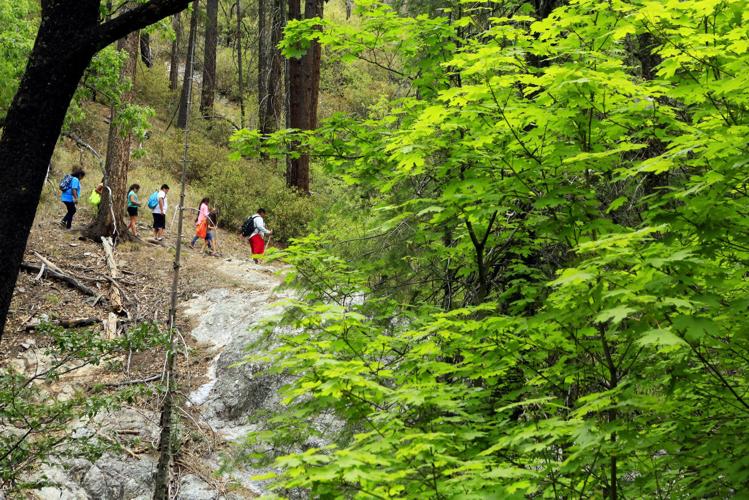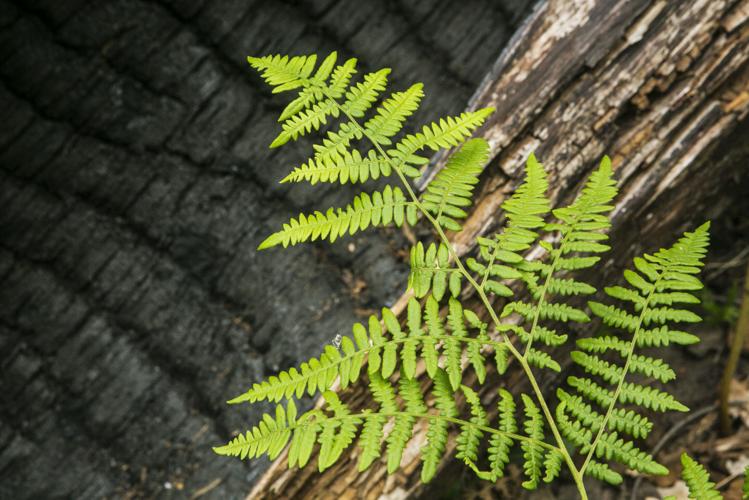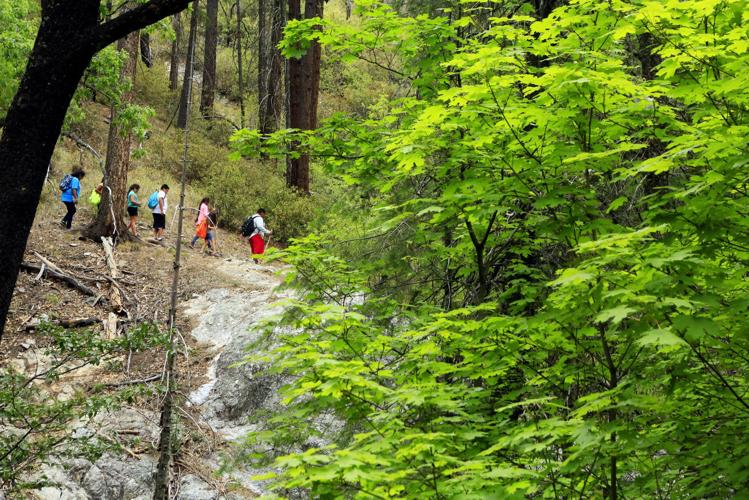Twelve years after the Aspen Fire roared over the Catalina Mountains, once-blackened slopes are showing expanses of bright green new growth — a heartening sign that the forest is on the road to recovery.
But it will be a long road.
Aspen and locust trees, ferns and other plants that flourish after fires are greening the mountain landscape and gaining some size.
Still, the burned areas are far from their pre-fire appearance — and forest experts say it will be decades, many decades, before stately pine and fir trees can re-create woodlands that went up in smoke. And changing climate conditions could result in a “replacement forest” visually different from the one familiar to generations of Tucsonans.
Heidi Schewel of the U.S. Forest Service — drawing on records and the expertise of scientists — provided an overview of the fire and the slow but clearly evident recovery of the forest.
It burned for a month
The human-caused Aspen Fire started June 17, 2003, near Marshall Peak south of the village of Summerhaven in the Catalinas north of Tucson.
“Due to the location of the start, and environmental and forest conditions, fire suppression was a challenge from the start,” Schewel said. “On June 19, the fire spotted across Marshall Gulch into the communities of Summerhaven and Loma Linda — and 322 homes, seven commercial businesses and four outbuildings were destroyed.”
The flames raged until the fire was contained on July 15 after burning 84,715 acres — from desert vegetation and grasses at lower elevations to mixed conifer forests at elevations between 7,000 feet and the 9,157-foot summit of Mount Lemmon.
“Mosaic” damage
Exactly how burned areas will recover is a complex puzzle involving burning patterns, fire intensity, soil and moisture conditions, plants’ ability to resprout, and changing climatic conditions.
“The fire burned in a mosaic pattern, with some vegetation untouched, some completely consumed, and multiple degrees of consumption in between,” Schewel said.
“Fire intensity, consumption of the vegetation, will affect recovery,” she said. “Plants and plant communities that were unburned or burned at low to moderate intensity recover more quickly than those that burned at high intensity and suffered greater degrees of mortality.”
Soils throughout the burn area were affected differently depending on the intensity of the fire.
“High severity burning can leave soils hydrophobic, meaning they repel water, to varying degrees,” Schewel said. “This lack of ability to absorb water will hinder recovery of plant species.”
pines another matter
Return of mature evergreen forests can take many decades, even centuries, because conifers recover more slowly than other forest species.
“Some species resprout from root systems following fire,” Schewel said. “This will hasten recovery. At the higher elevations in mixed conifer forest, aspens are resprouting from underground root systems where they were present. Another species that moves in rapidly is New Mexico locust. Oaks also re-sprout from root systems.”
Some of the aspens that resprouted soon after the 2003 fire have grown to heights of well over 6 feet.
Ferns and wildflowers also recovered quickly after the fire — but the forest’s evergreen trees are another matter.
“Conifer trees — ponderosa pine, Southwestern white pine, Douglas fir, white fir — do not resprout from root systems,” Schewel said. “They must regenerate from seed or replanting, which we did to protect watersheds in some areas.”
climate uncertainty
Scientists say it’s possible that changing climate conditions could result in a regenerated forest that’s different from the one that existed before the fire. Some species, including those that require cooler high altitude weather, might not thrive if warming trends continue — and other species might move in to replace them.
But no one knows for sure at this point.
“With the uncertainty brought on by a changing climate, it is not possible to predict what the forest will look like, or when,” Schewel said. “There are too many unanswered questions. Are seed trees available to regenerate the conifers through seeding and germination? If so, will environmental conditions support them?”
RECREATION CONTINUES
Even as the forest slowly recovers, recreational activities are still available there, Schewel said.
“From hiking to camping, wildlife watching, wildflower viewing, mountain biking, bird-watching, scenic driving, or the myriad of other activities people enjoy on Mount Lemmon, opportunities abound,” she said.
A HIKER’S VIEW
Mountain resident and hiker Leigh Anne Thrasher is one of many who see clear signs that the mountain is on the mend.
A view toward the Mint Spring Trail near Summerhaven reveals that “the area is nearly all green in the spring now, hiding the burned trees,” Thrasher said. “In fact, over the years, it is clear the burned tree sticks are falling and new growth is obvious. The New Mexico locust and the aspen (trees) are in patches on that hillside as well, and it makes for a gorgeous fall.”
She said views from high points above Summerhaven include expanses of new growth and numerous new homes replacing those lost in the fire.
“The view into the town from Inspiration Rock is truly an inspiration,” Thrasher said. “Not only has Mother Nature shown her resilience, but our community has, too.”






